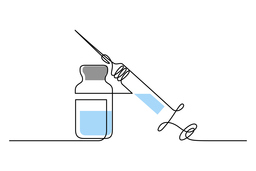Lipids for Nucleic Acid Based Vaccines
TECHNOLOGY NUMBER: 2022-117

OVERVIEW
A novel category of encompassing lipids to improve delivery of mRNA vaccines- Adds functional groups like N-methyl-tryptophan to lipid nanoparticles
- Provides better lipid nanoparticle encapsulation and macrophage polarization
BACKGROUND
The field of nanoparticles, or more specifically nanocarriers, as drug delivery methods has been growing for some time. Nanocarriers allow for increased stability of drugs in circulation, packaging of multiple drugs into individual particles for combination therapies, and modifications that increase cell and tissue specificity. Lipids can act as excellent nanocarriers because they are biodegradable, biocompatible, inert, nontoxic, non-immunogenic, easily available, and inexpensive. Lipid nanocarriers have been increasingly considered for delivery of mRNA-based therapeutics, given that mRNA molecules have relatively low stability and charged surfaces that prevent them from direct cell entry. Multiple nanotechnology-based delivery platforms have been studied, though a need exists for further refinement of those delivery methods of mRNA vaccines.
INNOVATION
University of Michigan researchers have developed a novel category of encompassing lipids with functional groups, such as N-methyl-tryptophan, to improve delivery of mRNA vaccines. The invention exhibits more effective encapsulation of lipid nanoparticles, macrophage polarization, and effectiveness in liposomal vaccine formulations. While mRNA particles are inherently large in size and susceptible to degradation by RNase, the proposed delivery vehicle provides an opportunity to solve these challenges. This new methodology may prove useful in the delivery of mRNA vaccines that are effective for a wide array of viral infections.